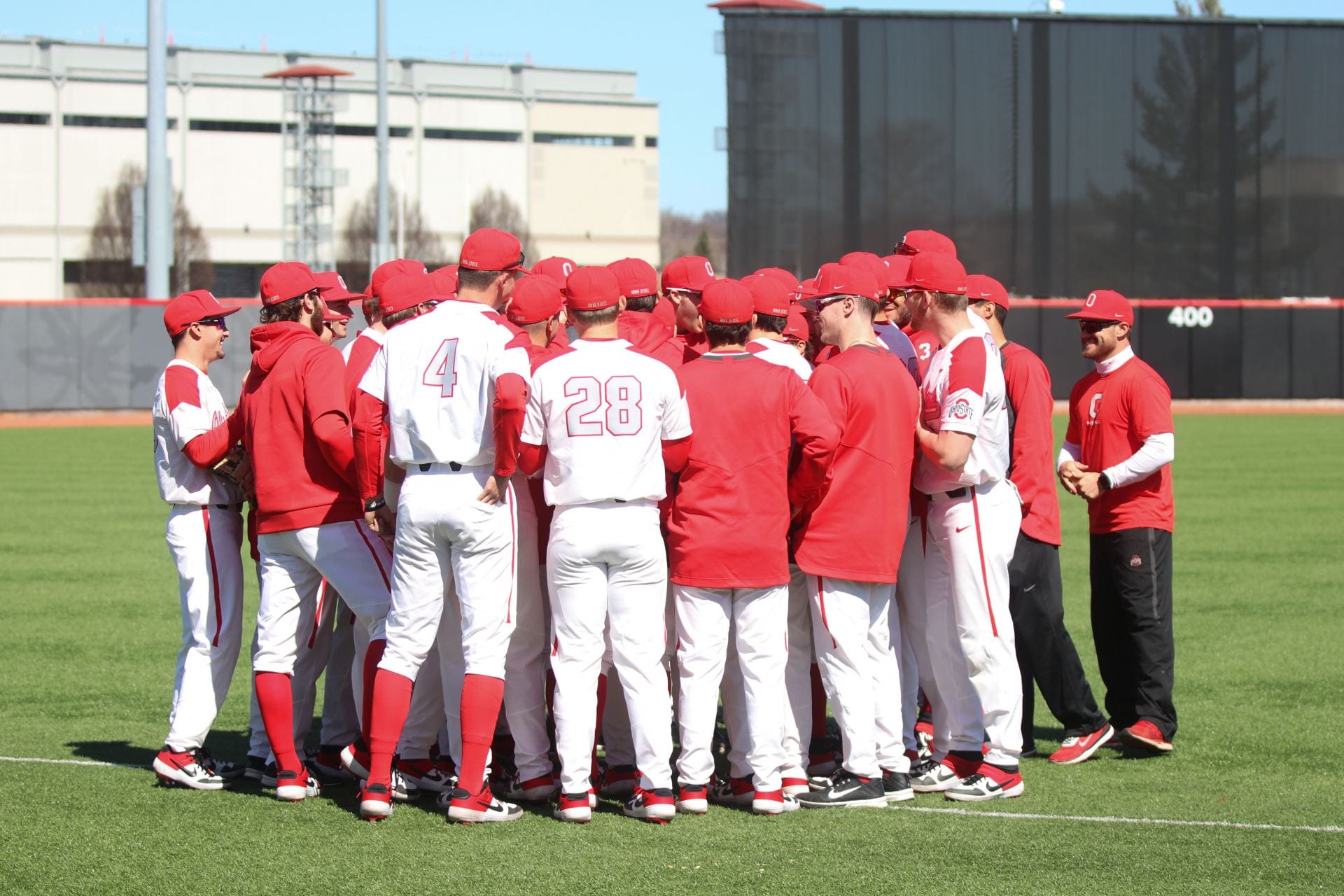
The Ohio State baseball team huddles up prior to the start of their game against Hawaii on March 23. Ohio State won 7-5. Credit: Casey Cascaldo | Lantern File Photo
Traditional baseball wisdom says that a head coach should roll out the same lineup every day to allow players to ease into their slots in the batting order, with players boasting the highest batting averages toward the top.
Ohio State head coach Greg Beals has not taken that approach, utilizing eight different lineup combinations in 11 games so far in 2021. Beals said he uses his self-calculated, original statistic run production average as one of the main statistics he uses to evaluate his offense.
“I’m the son of an accountant, so I like numbers, I crunch numbers,” Beals said March 14. “I also keep a run production average which is basically your runs, plus your RBI, minus your home runs, divided by your plate appearances to give you an idea not how many hits you’re getting per at-bat, but how many runs you’re producing for our ballclub.”
The reason the number of home runs is subtracted from the sum of runs and RBI is because a hitter earns a run and an RBI any time they hit a home run, which would skew the number of runs they produce per plate appearance.
(Runs + RBIs – Home Runs) ÷ (Plate Appearances)
The team’s collective run production average in 2021 is .197 with sophomore outfielder Mitchell Okuley, whose six runs, eight RBIs and three home runs in 39 plate appearances lead the team at .282 — 11 percentage points higher than freshman outfielder Kade Kern in second.
Okuley hit sixth in Ohio State’s lineup for all three games in its series against Rutgers.
Rounding out the top six in run production average in order is junior shortstop Zach Dezenzo at .260, senior second baseman Colton Bauer at .234, senior designated hitter Sam Wilson at .208 and redshirt senior first baseman Conner Pohl at .184.
Five of the Buckeyes’ 11 lineups have featured all six of the highest RPAs in the top six spots. In those games, Ohio State is 3-2 but has scored a total of 26 of its 50 runs on the season.
The other two ways Beals said he evaluates his hitters is through a hard-hit ball and quality at-bats chart.
Hard-hit balls are more of a visual stat since Beals can see if a ball is hit hard or not, but a quality at-bat is not as clear cut, coming in many different forms, Beals said.
“Quality at-bats are reaching base, getting RBI, moving runners and all that’s part of quality at-bats,” Beals said. “(Junior third baseman) Nick Erwin’s first hit was two strikes, poked it through the right side. He gets a quality at-bat, no doubt, but he doesn’t get a hard hit on that. It’s a very competitive, great at-bat. (Sophomore infielder Nate) Karaffa gets hit by a pitch, gets a sacrifice bunt, those are two quality at-bats.”
Beals said he tracks these so players focus on having productive plate appearances, even if that means they do not reach base. He said this helps with a player’s confidence.
“I don’t want our guys worrying about their batting average; I want them worried about the process and executing the process,” Beals said. “If they’re not getting hits and their quality at-bats number or their hard-hit number’s solid, that can keep them motivated and keep them going.”
Erwin said Beals’ intentions of those stats building confidence are working.
“If balls didn’t fall free that day, you didn’t get a couple knocks, but you see that you’re having quality at-bats and hitting balls hard, then you know that your approach and your mental side to offense is there,” Erwin said Saturday. “Seeing that’s always kind of refreshing. It’s good to know that you’re at least on the right path.”


